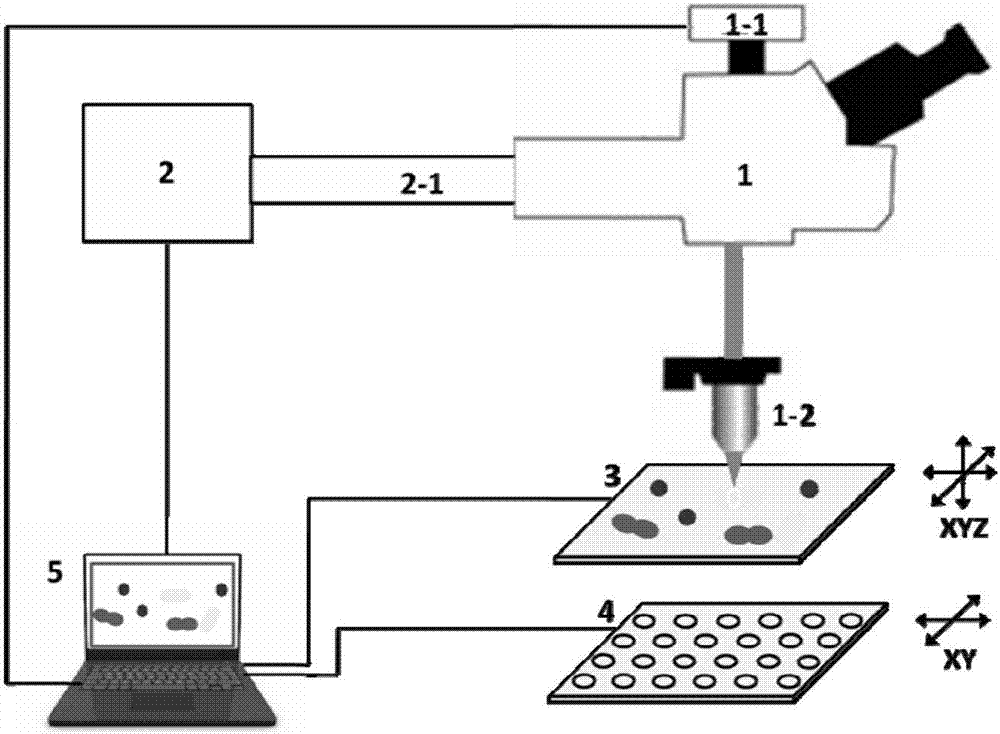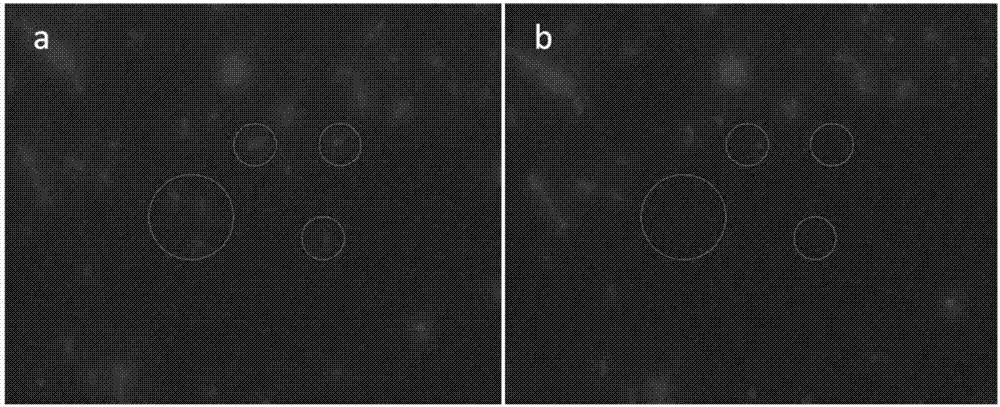High-throughput automatic sorting and receiving system for microorganism single cells
A receiving system and single-cell technology, applied in the direction of material analysis, measuring devices, and analysis materials through optical means, can solve the problem of less cell information, achieve high processing throughput, low hardware cost, automatic sorting and receiving Effect
- Summary
- Abstract
- Description
- Claims
- Application Information
AI Technical Summary
Problems solved by technology
Method used
Image
Examples
Embodiment 1
[0040] Example 1: Microbial single cell sorting based on fluorescence imaging
[0041] figure 1 Shown is a schematic diagram of a high-throughput single-cell automatic sorting and receiving system. It can be seen from the figure that the present invention provides a high-throughput single-cell automatic sorting and receiving system, including a microscopic imaging module 1, a pulsed laser module 2, and a cell separation module. 3. The cell receiving module 4 and the control terminal 5, the connection relationship of the above components is as follows:
[0042]The microscopic imaging module 1 is based on an upright microscope, and includes a CCD 1-1 for imaging and a plurality of focusing objective lenses 1-2. The pulsed laser module 2 is coupled with the microscopic imaging module 1 through an optical path 2-1. Cells The separation module 3 is placed in the microscopic imaging module 1. The cell separation module 3 includes the first automatic displacement loading platform an...
Embodiment 2
[0050] Embodiment 2: Microbial single cell sorting based on Raman spectroscopy
[0051] The following is an embodiment of microbial single cell sorting based on Raman spectroscopy: wherein:
[0052] The microscopic imaging module 1 includes a commercial upright Raman microscope system (model BX-41, purchased from Olympus);
[0053] Pulse laser module 2 is a pulse laser with a wavelength of 532nm (model PULSELAS-P-532-300, purchased from ALPHALAS company), the laser pulse width is 1nm, the maximum single pulse energy is 10μJ, and the pulse frequency is: 5-16.6kHz;
[0054] The cell separation module 3 includes a first automatic displacement loading platform and a laser ejection substrate, the base layer material of the laser ejection substrate is silicate glass; the coating film material is ITO;
[0055] The cell receiving module 4 includes a second automatic displacement loading platform and a 384-well plate.
[0056] The method for using the above-mentioned high-throughput ...
Embodiment 3
[0058] Example 3: Single cell sorting coupled with single cell genome manipulation
[0059] In order to further verify that the single cells sorted by the above-mentioned high-throughput single cell automatic sorting and receiving system are the desired cells, the single cells obtained by sorting are subjected to genome manipulation. The operation process is as follows:
[0060] Escherichia coli single cells in Example 1 were ejected and sorted into 9 receiving microwells, alkaline lysate was added to lyse the cells, and then transferred to centrifuge tubes and nucleic acid amplification mixed reagents and amplification enzymes were added, using The MDA amplification method amplifies the single-cell genome, and performs PCR verification on the product, and obtains as follows: Figure 4 In the gel electrophoresis images shown, #1 to #9 in the figure are the results of single cells obtained by ejection sorting, and N1 and N2 are negative controls that do not contain any cells. ...
PUM
| Property | Measurement | Unit |
|---|---|---|
| thickness | aaaaa | aaaaa |
| wavelength | aaaaa | aaaaa |
| length | aaaaa | aaaaa |
Abstract
Description
Claims
Application Information
 Login to View More
Login to View More - R&D
- Intellectual Property
- Life Sciences
- Materials
- Tech Scout
- Unparalleled Data Quality
- Higher Quality Content
- 60% Fewer Hallucinations
Browse by: Latest US Patents, China's latest patents, Technical Efficacy Thesaurus, Application Domain, Technology Topic, Popular Technical Reports.
© 2025 PatSnap. All rights reserved.Legal|Privacy policy|Modern Slavery Act Transparency Statement|Sitemap|About US| Contact US: help@patsnap.com



